IFRS Audit Assignment: Prudence and the Conceptual Framework
VerifiedAdded on 2023/06/04
|12
|2698
|421
Report
AI Summary
This assignment delves into the concept of prudence within the conceptual framework of financial reporting, particularly in the context of International Financial Reporting Standards (IFRS). It discusses the historical inclusion and subsequent removal of prudence from the IASB's conceptual framework, examining the arguments for and against its inclusion. The analysis highlights the ambiguity associated with prudence, its potential conflict with neutrality and faithful representation, and the concerns about overly optimistic reporting. The assignment also includes a letter from Big Phore Partners providing comments on the IASB's Exposure Draft, emphasizing the importance of prudence in ensuring the reliability of financial statements. The report concludes that while prudence should be included, it must be applied cautiously to avoid misuse and maintain a balanced view of financial performance. Desklib offers this document as a resource for students, providing access to a wide range of solved assignments and past papers.
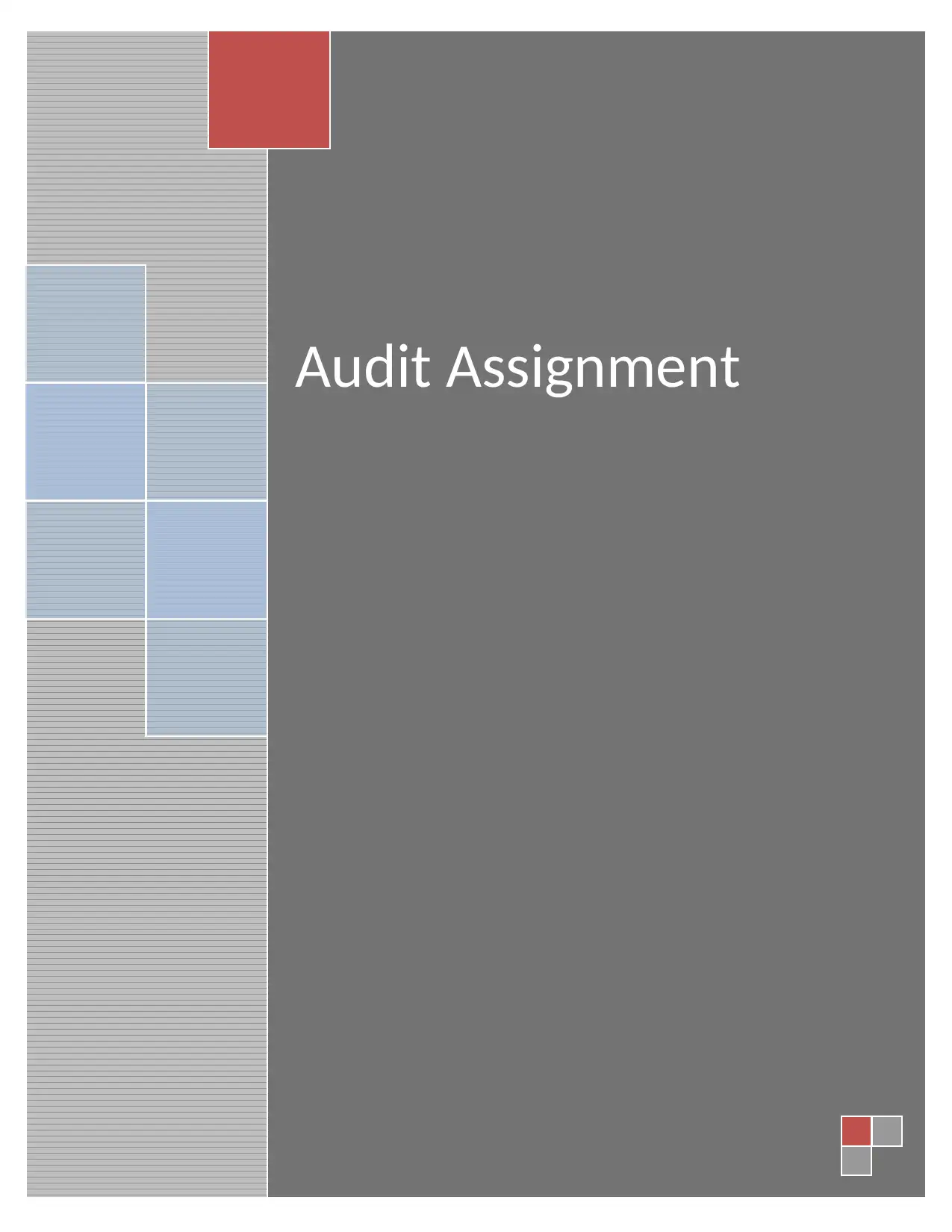
Audit Assignment
Paraphrase This Document
Need a fresh take? Get an instant paraphrase of this document with our AI Paraphraser

1
By student name
Professor
University
Date: 20th Sep 2018.
1 | P a g e
By student name
Professor
University
Date: 20th Sep 2018.
1 | P a g e
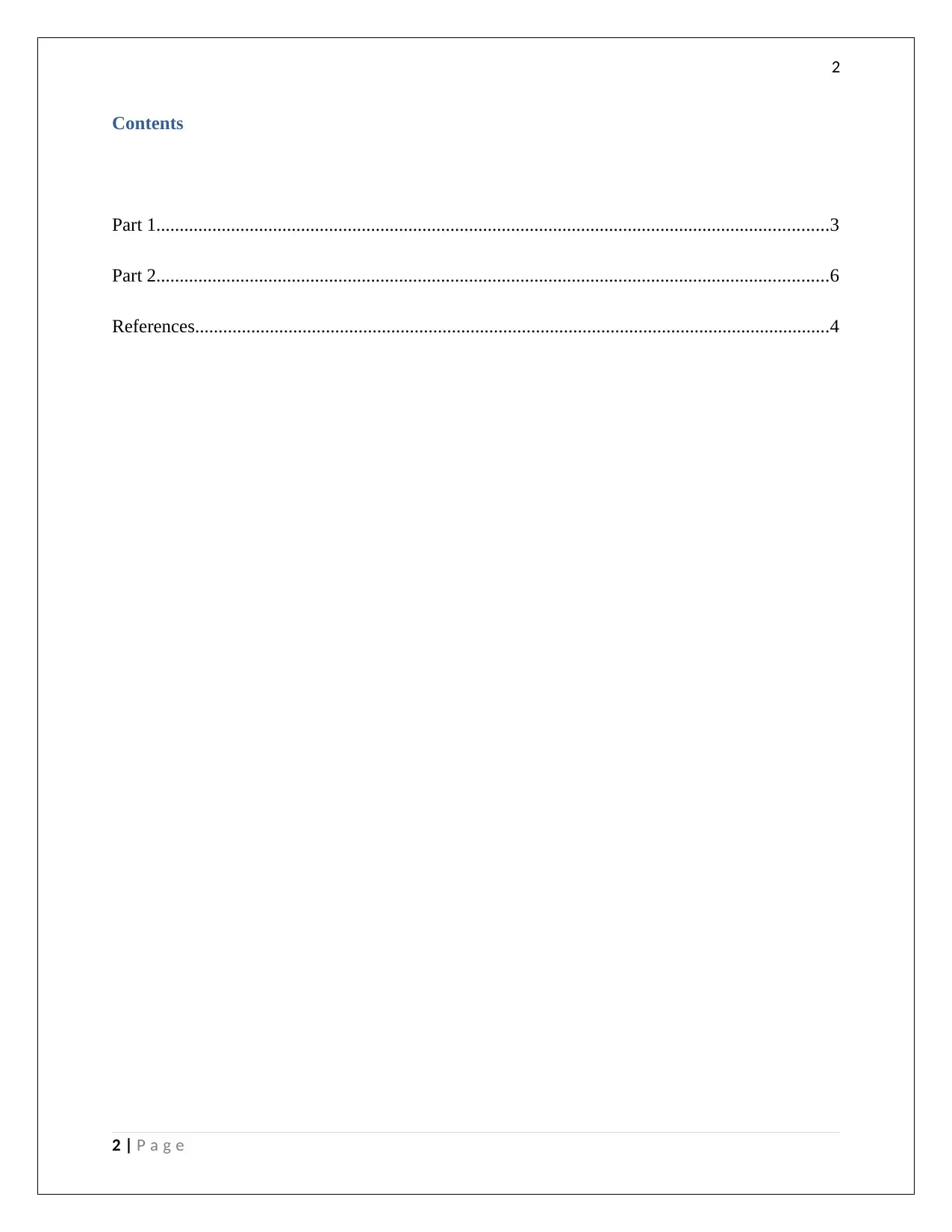
2
Contents
Part 1................................................................................................................................................3
Part 2................................................................................................................................................6
References........................................................................................................................................4
2 | P a g e
Contents
Part 1................................................................................................................................................3
Part 2................................................................................................................................................6
References........................................................................................................................................4
2 | P a g e
⊘ This is a preview!⊘
Do you want full access?
Subscribe today to unlock all pages.

Trusted by 1+ million students worldwide
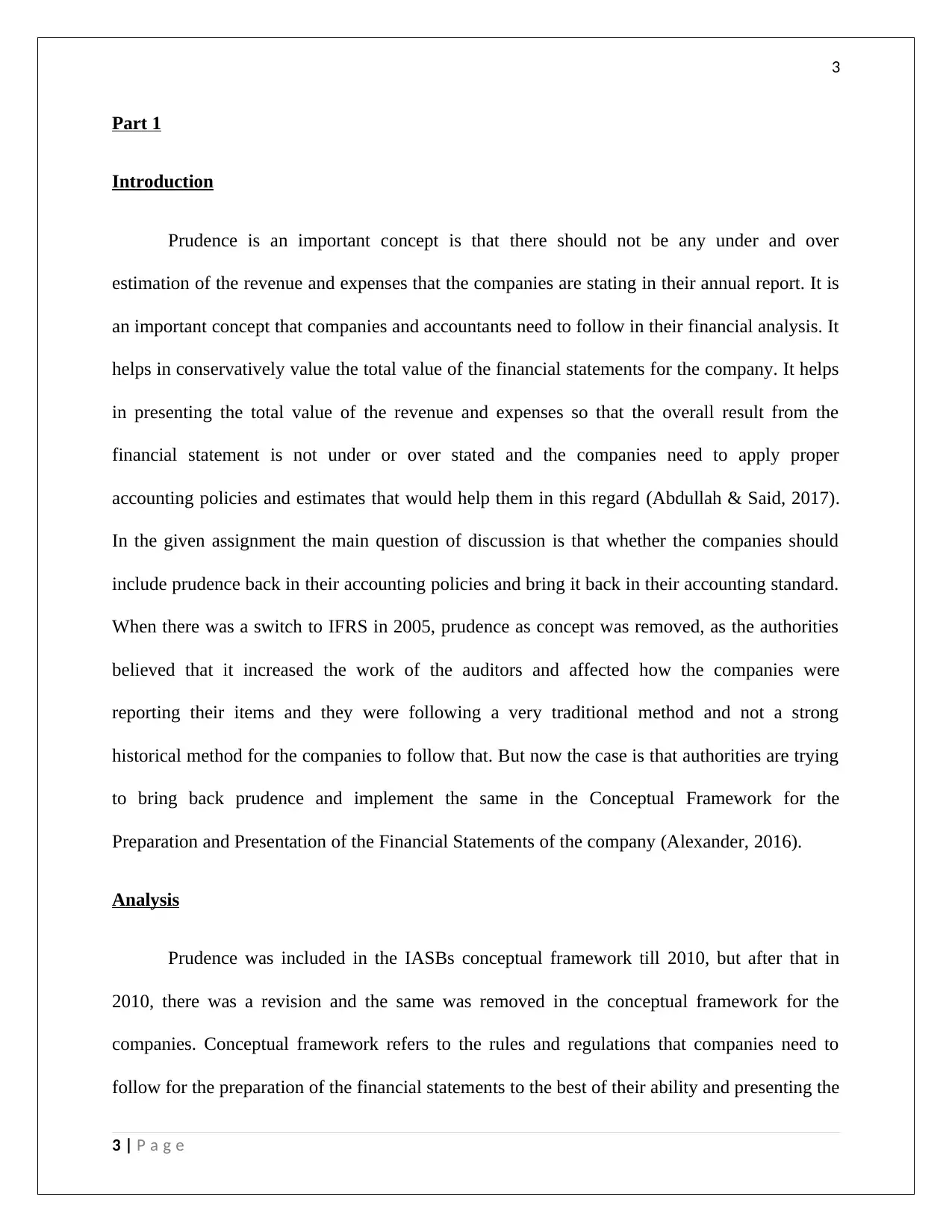
3
Part 1
Introduction
Prudence is an important concept is that there should not be any under and over
estimation of the revenue and expenses that the companies are stating in their annual report. It is
an important concept that companies and accountants need to follow in their financial analysis. It
helps in conservatively value the total value of the financial statements for the company. It helps
in presenting the total value of the revenue and expenses so that the overall result from the
financial statement is not under or over stated and the companies need to apply proper
accounting policies and estimates that would help them in this regard (Abdullah & Said, 2017).
In the given assignment the main question of discussion is that whether the companies should
include prudence back in their accounting policies and bring it back in their accounting standard.
When there was a switch to IFRS in 2005, prudence as concept was removed, as the authorities
believed that it increased the work of the auditors and affected how the companies were
reporting their items and they were following a very traditional method and not a strong
historical method for the companies to follow that. But now the case is that authorities are trying
to bring back prudence and implement the same in the Conceptual Framework for the
Preparation and Presentation of the Financial Statements of the company (Alexander, 2016).
Analysis
Prudence was included in the IASBs conceptual framework till 2010, but after that in
2010, there was a revision and the same was removed in the conceptual framework for the
companies. Conceptual framework refers to the rules and regulations that companies need to
follow for the preparation of the financial statements to the best of their ability and presenting the
3 | P a g e
Part 1
Introduction
Prudence is an important concept is that there should not be any under and over
estimation of the revenue and expenses that the companies are stating in their annual report. It is
an important concept that companies and accountants need to follow in their financial analysis. It
helps in conservatively value the total value of the financial statements for the company. It helps
in presenting the total value of the revenue and expenses so that the overall result from the
financial statement is not under or over stated and the companies need to apply proper
accounting policies and estimates that would help them in this regard (Abdullah & Said, 2017).
In the given assignment the main question of discussion is that whether the companies should
include prudence back in their accounting policies and bring it back in their accounting standard.
When there was a switch to IFRS in 2005, prudence as concept was removed, as the authorities
believed that it increased the work of the auditors and affected how the companies were
reporting their items and they were following a very traditional method and not a strong
historical method for the companies to follow that. But now the case is that authorities are trying
to bring back prudence and implement the same in the Conceptual Framework for the
Preparation and Presentation of the Financial Statements of the company (Alexander, 2016).
Analysis
Prudence was included in the IASBs conceptual framework till 2010, but after that in
2010, there was a revision and the same was removed in the conceptual framework for the
companies. Conceptual framework refers to the rules and regulations that companies need to
follow for the preparation of the financial statements to the best of their ability and presenting the
3 | P a g e
Paraphrase This Document
Need a fresh take? Get an instant paraphrase of this document with our AI Paraphraser
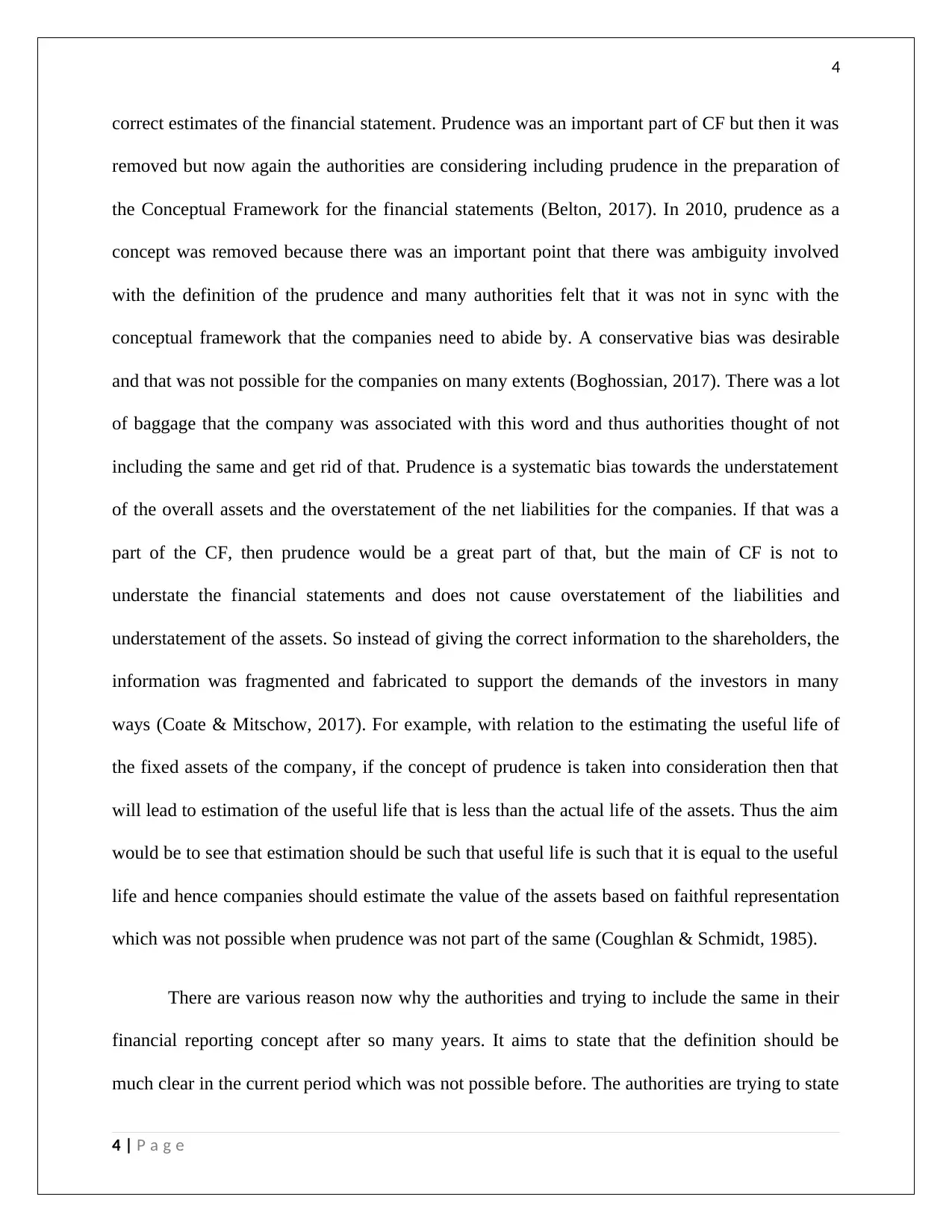
4
correct estimates of the financial statement. Prudence was an important part of CF but then it was
removed but now again the authorities are considering including prudence in the preparation of
the Conceptual Framework for the financial statements (Belton, 2017). In 2010, prudence as a
concept was removed because there was an important point that there was ambiguity involved
with the definition of the prudence and many authorities felt that it was not in sync with the
conceptual framework that the companies need to abide by. A conservative bias was desirable
and that was not possible for the companies on many extents (Boghossian, 2017). There was a lot
of baggage that the company was associated with this word and thus authorities thought of not
including the same and get rid of that. Prudence is a systematic bias towards the understatement
of the overall assets and the overstatement of the net liabilities for the companies. If that was a
part of the CF, then prudence would be a great part of that, but the main of CF is not to
understate the financial statements and does not cause overstatement of the liabilities and
understatement of the assets. So instead of giving the correct information to the shareholders, the
information was fragmented and fabricated to support the demands of the investors in many
ways (Coate & Mitschow, 2017). For example, with relation to the estimating the useful life of
the fixed assets of the company, if the concept of prudence is taken into consideration then that
will lead to estimation of the useful life that is less than the actual life of the assets. Thus the aim
would be to see that estimation should be such that useful life is such that it is equal to the useful
life and hence companies should estimate the value of the assets based on faithful representation
which was not possible when prudence was not part of the same (Coughlan & Schmidt, 1985).
There are various reason now why the authorities and trying to include the same in their
financial reporting concept after so many years. It aims to state that the definition should be
much clear in the current period which was not possible before. The authorities are trying to state
4 | P a g e
correct estimates of the financial statement. Prudence was an important part of CF but then it was
removed but now again the authorities are considering including prudence in the preparation of
the Conceptual Framework for the financial statements (Belton, 2017). In 2010, prudence as a
concept was removed because there was an important point that there was ambiguity involved
with the definition of the prudence and many authorities felt that it was not in sync with the
conceptual framework that the companies need to abide by. A conservative bias was desirable
and that was not possible for the companies on many extents (Boghossian, 2017). There was a lot
of baggage that the company was associated with this word and thus authorities thought of not
including the same and get rid of that. Prudence is a systematic bias towards the understatement
of the overall assets and the overstatement of the net liabilities for the companies. If that was a
part of the CF, then prudence would be a great part of that, but the main of CF is not to
understate the financial statements and does not cause overstatement of the liabilities and
understatement of the assets. So instead of giving the correct information to the shareholders, the
information was fragmented and fabricated to support the demands of the investors in many
ways (Coate & Mitschow, 2017). For example, with relation to the estimating the useful life of
the fixed assets of the company, if the concept of prudence is taken into consideration then that
will lead to estimation of the useful life that is less than the actual life of the assets. Thus the aim
would be to see that estimation should be such that useful life is such that it is equal to the useful
life and hence companies should estimate the value of the assets based on faithful representation
which was not possible when prudence was not part of the same (Coughlan & Schmidt, 1985).
There are various reason now why the authorities and trying to include the same in their
financial reporting concept after so many years. It aims to state that the definition should be
much clear in the current period which was not possible before. The authorities are trying to state
4 | P a g e
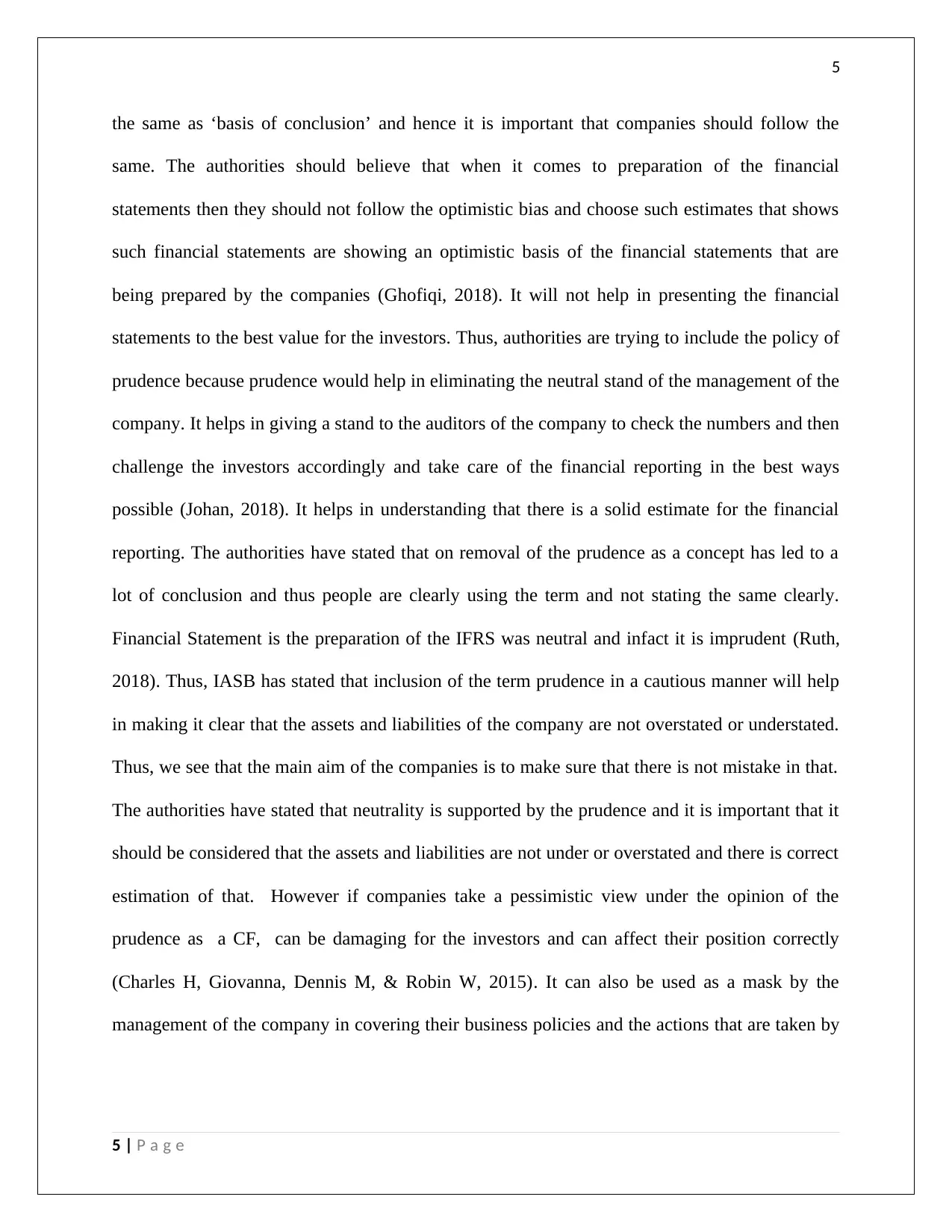
5
the same as ‘basis of conclusion’ and hence it is important that companies should follow the
same. The authorities should believe that when it comes to preparation of the financial
statements then they should not follow the optimistic bias and choose such estimates that shows
such financial statements are showing an optimistic basis of the financial statements that are
being prepared by the companies (Ghofiqi, 2018). It will not help in presenting the financial
statements to the best value for the investors. Thus, authorities are trying to include the policy of
prudence because prudence would help in eliminating the neutral stand of the management of the
company. It helps in giving a stand to the auditors of the company to check the numbers and then
challenge the investors accordingly and take care of the financial reporting in the best ways
possible (Johan, 2018). It helps in understanding that there is a solid estimate for the financial
reporting. The authorities have stated that on removal of the prudence as a concept has led to a
lot of conclusion and thus people are clearly using the term and not stating the same clearly.
Financial Statement is the preparation of the IFRS was neutral and infact it is imprudent (Ruth,
2018). Thus, IASB has stated that inclusion of the term prudence in a cautious manner will help
in making it clear that the assets and liabilities of the company are not overstated or understated.
Thus, we see that the main aim of the companies is to make sure that there is not mistake in that.
The authorities have stated that neutrality is supported by the prudence and it is important that it
should be considered that the assets and liabilities are not under or overstated and there is correct
estimation of that. However if companies take a pessimistic view under the opinion of the
prudence as a CF, can be damaging for the investors and can affect their position correctly
(Charles H, Giovanna, Dennis M, & Robin W, 2015). It can also be used as a mask by the
management of the company in covering their business policies and the actions that are taken by
5 | P a g e
the same as ‘basis of conclusion’ and hence it is important that companies should follow the
same. The authorities should believe that when it comes to preparation of the financial
statements then they should not follow the optimistic bias and choose such estimates that shows
such financial statements are showing an optimistic basis of the financial statements that are
being prepared by the companies (Ghofiqi, 2018). It will not help in presenting the financial
statements to the best value for the investors. Thus, authorities are trying to include the policy of
prudence because prudence would help in eliminating the neutral stand of the management of the
company. It helps in giving a stand to the auditors of the company to check the numbers and then
challenge the investors accordingly and take care of the financial reporting in the best ways
possible (Johan, 2018). It helps in understanding that there is a solid estimate for the financial
reporting. The authorities have stated that on removal of the prudence as a concept has led to a
lot of conclusion and thus people are clearly using the term and not stating the same clearly.
Financial Statement is the preparation of the IFRS was neutral and infact it is imprudent (Ruth,
2018). Thus, IASB has stated that inclusion of the term prudence in a cautious manner will help
in making it clear that the assets and liabilities of the company are not overstated or understated.
Thus, we see that the main aim of the companies is to make sure that there is not mistake in that.
The authorities have stated that neutrality is supported by the prudence and it is important that it
should be considered that the assets and liabilities are not under or overstated and there is correct
estimation of that. However if companies take a pessimistic view under the opinion of the
prudence as a CF, can be damaging for the investors and can affect their position correctly
(Charles H, Giovanna, Dennis M, & Robin W, 2015). It can also be used as a mask by the
management of the company in covering their business policies and the actions that are taken by
5 | P a g e
⊘ This is a preview!⊘
Do you want full access?
Subscribe today to unlock all pages.

Trusted by 1+ million students worldwide
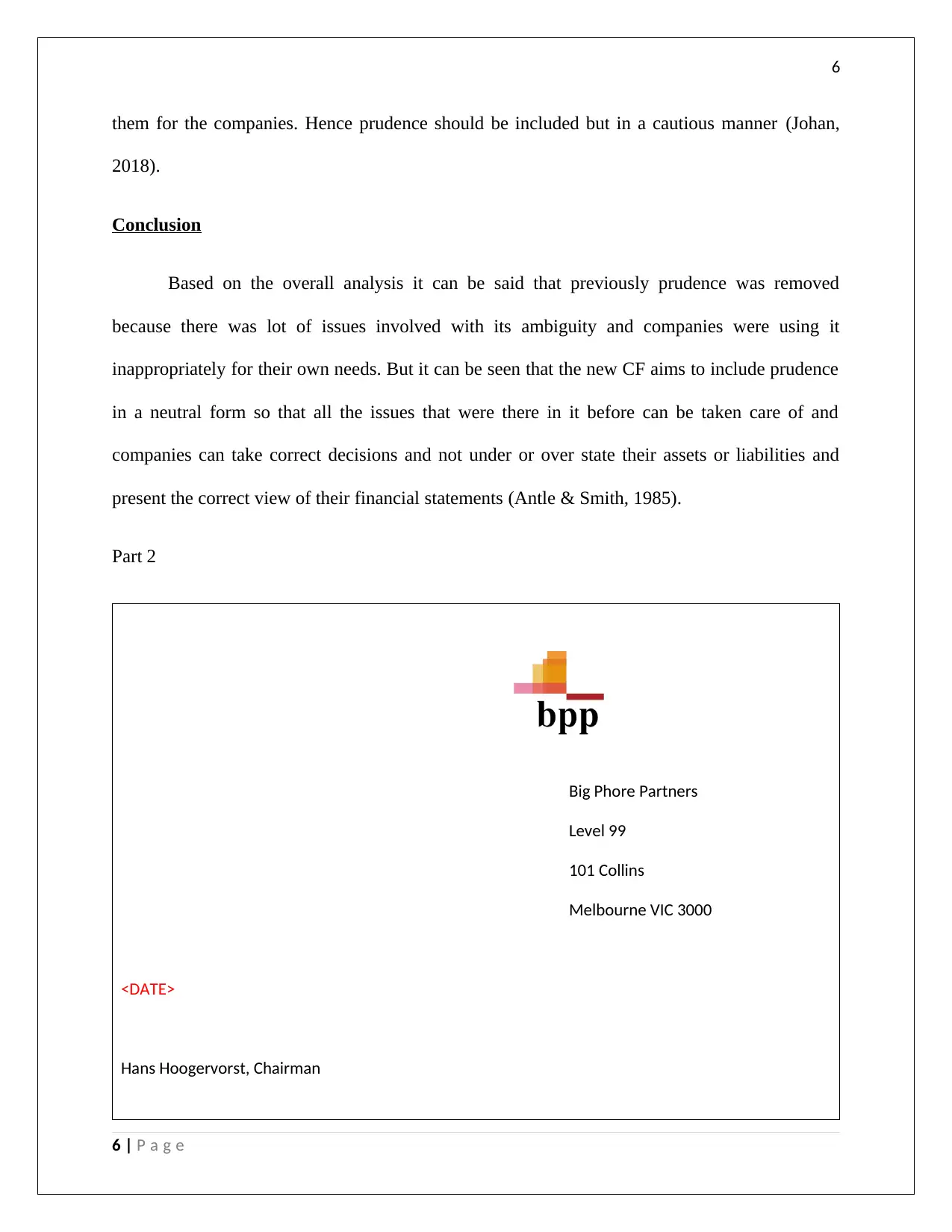
6
them for the companies. Hence prudence should be included but in a cautious manner (Johan,
2018).
Conclusion
Based on the overall analysis it can be said that previously prudence was removed
because there was lot of issues involved with its ambiguity and companies were using it
inappropriately for their own needs. But it can be seen that the new CF aims to include prudence
in a neutral form so that all the issues that were there in it before can be taken care of and
companies can take correct decisions and not under or over state their assets or liabilities and
present the correct view of their financial statements (Antle & Smith, 1985).
Part 2
Big Phore Partners
Level 99
101 Collins
Melbourne VIC 3000
<DATE>
Hans Hoogervorst, Chairman
6 | P a g e
them for the companies. Hence prudence should be included but in a cautious manner (Johan,
2018).
Conclusion
Based on the overall analysis it can be said that previously prudence was removed
because there was lot of issues involved with its ambiguity and companies were using it
inappropriately for their own needs. But it can be seen that the new CF aims to include prudence
in a neutral form so that all the issues that were there in it before can be taken care of and
companies can take correct decisions and not under or over state their assets or liabilities and
present the correct view of their financial statements (Antle & Smith, 1985).
Part 2
Big Phore Partners
Level 99
101 Collins
Melbourne VIC 3000
<DATE>
Hans Hoogervorst, Chairman
6 | P a g e
Paraphrase This Document
Need a fresh take? Get an instant paraphrase of this document with our AI Paraphraser

7
International Accounting Standards Board
30 Cannon Street
London EC4M 6XH
United Kingdom
Re: Exposure Draft ED/2015/3 Conceptual Framework for Financial Reporting
Dear Chair Hoogervorst:
On behalf of our clients and team at Big Phore Partners, we thank you for the opportunity to provide
our comments on the International Accounting Standards Board's (IASB) Exposure Draft (ED)
regarding Conceptual Framework for Financial Reporting (CF).
Prudence as a concept is of great importance in the world of conceptual framework and reporting. It
aims to state the correct value of the assets and liabilities and over or under state them. There is a
quality that is associated with prudence that aims at opiminstic approach of the management in the
preparation of the financial statements. Prudence is a quality that helps in improving the overall
financial viability of the financial statements and comment on their overall betterment.This might
often leads to situation in which the overall assessment of the financial statements is not correct and
the solutions are over under or over stated. It is because of this the concept of prudence was
removed in 2010, as there was a lot ambiguity that was associated with it and the investors and all
the other stakeholders had to face a lot of issues. But now again the authorities are trying to
incoproarte prudence as a principles in the prepeartion of the financial statements and there are a lot
of reasons why they are doing so. Few of these reasons are clear to the management of the company
and they are considering inclusion of prudence in their conceptual framework system. The authorities
have given us an opportunity so that we can place our view on this inclusion of prudence and there
are various comments that other professionals have also given. All these claims and reasosn are of
utmost importance to the authorities and they can decide on mutual grounds whether they are
considering prudence or not. Prudence is a vague concept but the modifications that the
management has stated are relevant and are presenting a totally different picture of the overall
7 | P a g e
International Accounting Standards Board
30 Cannon Street
London EC4M 6XH
United Kingdom
Re: Exposure Draft ED/2015/3 Conceptual Framework for Financial Reporting
Dear Chair Hoogervorst:
On behalf of our clients and team at Big Phore Partners, we thank you for the opportunity to provide
our comments on the International Accounting Standards Board's (IASB) Exposure Draft (ED)
regarding Conceptual Framework for Financial Reporting (CF).
Prudence as a concept is of great importance in the world of conceptual framework and reporting. It
aims to state the correct value of the assets and liabilities and over or under state them. There is a
quality that is associated with prudence that aims at opiminstic approach of the management in the
preparation of the financial statements. Prudence is a quality that helps in improving the overall
financial viability of the financial statements and comment on their overall betterment.This might
often leads to situation in which the overall assessment of the financial statements is not correct and
the solutions are over under or over stated. It is because of this the concept of prudence was
removed in 2010, as there was a lot ambiguity that was associated with it and the investors and all
the other stakeholders had to face a lot of issues. But now again the authorities are trying to
incoproarte prudence as a principles in the prepeartion of the financial statements and there are a lot
of reasons why they are doing so. Few of these reasons are clear to the management of the company
and they are considering inclusion of prudence in their conceptual framework system. The authorities
have given us an opportunity so that we can place our view on this inclusion of prudence and there
are various comments that other professionals have also given. All these claims and reasosn are of
utmost importance to the authorities and they can decide on mutual grounds whether they are
considering prudence or not. Prudence is a vague concept but the modifications that the
management has stated are relevant and are presenting a totally different picture of the overall
7 | P a g e

8
scenario for the companies. It has stated with reasons why the prudence as a principle was removed
from the prior years conceptual framework concept and the overall issues that the authorities faced
because of that was also stated in the amendments that was brought in 2010. Bit agin in 2014, they
are considering taking prudence back in their vicinity as a concept that is more practical and less
vague. It is also considering the various issues that companies faced when they did not followed the
principles of prudence and it often led to under or over valuation of the financial statements of the
companies. There are various reasons based on which the authorities are considering the inclusion of
the same and as professionals we have the right that we can comment in for or against of that. So
based on such reasons and factors there are specific comments that we want to give from our side
and we are taking in consideration that authorities will gove importance to that points and also will
cosndier whether they want to incorporate them or not. We have also stated our specific reasons
based on which we are considering inclusion of the concept of prudence in the overall conceptual
framework concept. Few of those reasons are stated below for the analysis on part of the authorities.
Chapter 2 - Qualitative Characteristics of Useful Information
Question 1-Proposed changes to Chapters 2:
Do you support the proposal to reintroduce an explicit reference to the notion of prudence
(described as caution when making judgments under conditions of uncertainty) and to state
that prudence is important in achieving neutrality;
The authorities of the company believes that prudence should be included in the concept of
conceptual framework. As it will help in improving the overall quality of the financial
statements.There are few points that authorities needs to state which includes:
The authorties have changed the definition of prudence and there is inclusion of the concept of
neutrality in that. Previously this was not part of the total definition of the prudence and thus
because of that the companies would overstate the assets and an optimisation attitude was
adopted by them. There was no understatement of liabilities allowed and hence we see that the
companies were staing a position which was not actually there and were presenting a wrong
opinion to the shareholders or the investors of the company. So now if they are including
prudence they are changing the overall scenario and have adopted a cautious attitude overall and
8 | P a g e
scenario for the companies. It has stated with reasons why the prudence as a principle was removed
from the prior years conceptual framework concept and the overall issues that the authorities faced
because of that was also stated in the amendments that was brought in 2010. Bit agin in 2014, they
are considering taking prudence back in their vicinity as a concept that is more practical and less
vague. It is also considering the various issues that companies faced when they did not followed the
principles of prudence and it often led to under or over valuation of the financial statements of the
companies. There are various reasons based on which the authorities are considering the inclusion of
the same and as professionals we have the right that we can comment in for or against of that. So
based on such reasons and factors there are specific comments that we want to give from our side
and we are taking in consideration that authorities will gove importance to that points and also will
cosndier whether they want to incorporate them or not. We have also stated our specific reasons
based on which we are considering inclusion of the concept of prudence in the overall conceptual
framework concept. Few of those reasons are stated below for the analysis on part of the authorities.
Chapter 2 - Qualitative Characteristics of Useful Information
Question 1-Proposed changes to Chapters 2:
Do you support the proposal to reintroduce an explicit reference to the notion of prudence
(described as caution when making judgments under conditions of uncertainty) and to state
that prudence is important in achieving neutrality;
The authorities of the company believes that prudence should be included in the concept of
conceptual framework. As it will help in improving the overall quality of the financial
statements.There are few points that authorities needs to state which includes:
The authorties have changed the definition of prudence and there is inclusion of the concept of
neutrality in that. Previously this was not part of the total definition of the prudence and thus
because of that the companies would overstate the assets and an optimisation attitude was
adopted by them. There was no understatement of liabilities allowed and hence we see that the
companies were staing a position which was not actually there and were presenting a wrong
opinion to the shareholders or the investors of the company. So now if they are including
prudence they are changing the overall scenario and have adopted a cautious attitude overall and
8 | P a g e
⊘ This is a preview!⊘
Do you want full access?
Subscribe today to unlock all pages.

Trusted by 1+ million students worldwide
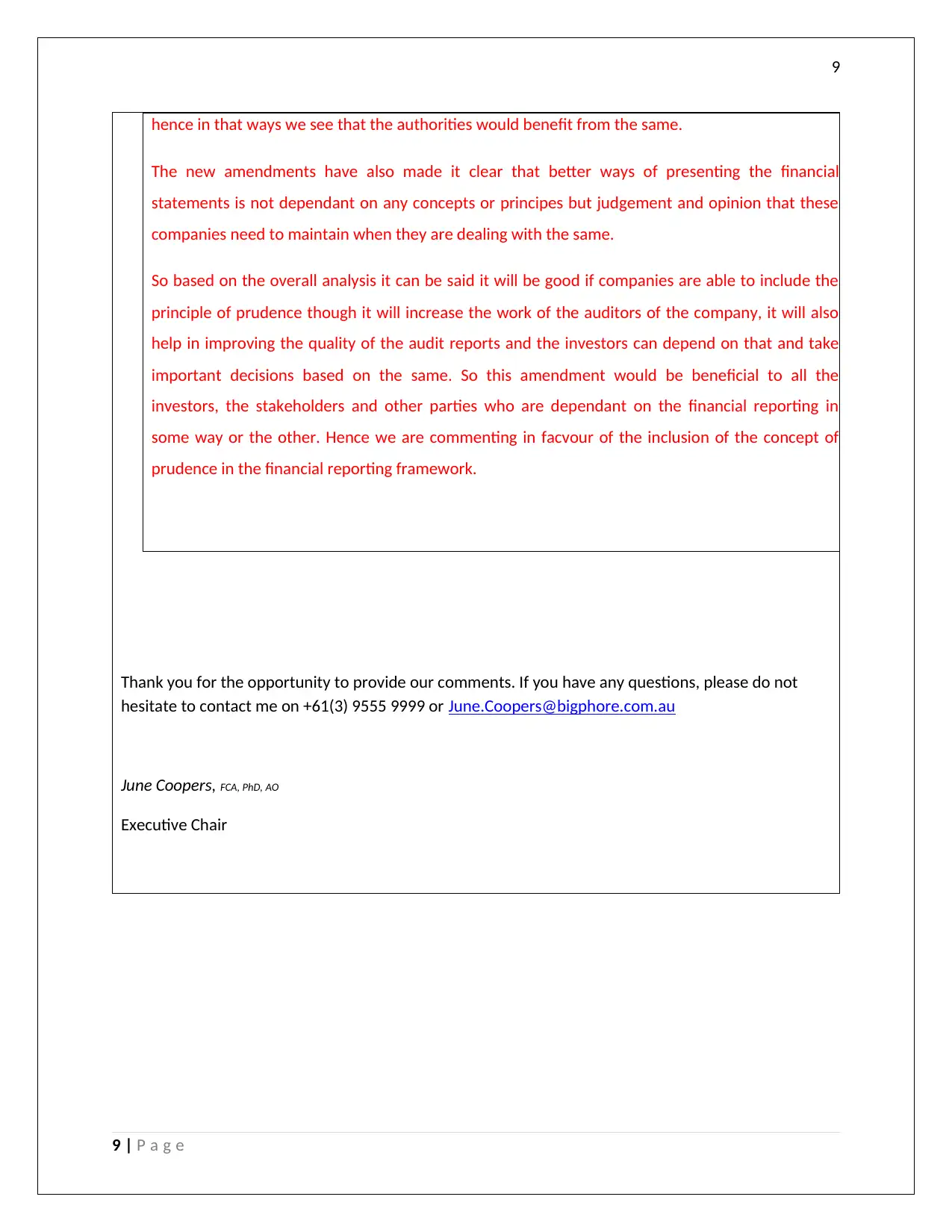
9
hence in that ways we see that the authorities would benefit from the same.
The new amendments have also made it clear that better ways of presenting the financial
statements is not dependant on any concepts or principes but judgement and opinion that these
companies need to maintain when they are dealing with the same.
So based on the overall analysis it can be said it will be good if companies are able to include the
principle of prudence though it will increase the work of the auditors of the company, it will also
help in improving the quality of the audit reports and the investors can depend on that and take
important decisions based on the same. So this amendment would be beneficial to all the
investors, the stakeholders and other parties who are dependant on the financial reporting in
some way or the other. Hence we are commenting in facvour of the inclusion of the concept of
prudence in the financial reporting framework.
Thank you for the opportunity to provide our comments. If you have any questions, please do not
hesitate to contact me on +61(3) 9555 9999 or June.Coopers@bigphore.com.au
June Coopers, FCA, PhD, AO
Executive Chair
9 | P a g e
hence in that ways we see that the authorities would benefit from the same.
The new amendments have also made it clear that better ways of presenting the financial
statements is not dependant on any concepts or principes but judgement and opinion that these
companies need to maintain when they are dealing with the same.
So based on the overall analysis it can be said it will be good if companies are able to include the
principle of prudence though it will increase the work of the auditors of the company, it will also
help in improving the quality of the audit reports and the investors can depend on that and take
important decisions based on the same. So this amendment would be beneficial to all the
investors, the stakeholders and other parties who are dependant on the financial reporting in
some way or the other. Hence we are commenting in facvour of the inclusion of the concept of
prudence in the financial reporting framework.
Thank you for the opportunity to provide our comments. If you have any questions, please do not
hesitate to contact me on +61(3) 9555 9999 or June.Coopers@bigphore.com.au
June Coopers, FCA, PhD, AO
Executive Chair
9 | P a g e
Paraphrase This Document
Need a fresh take? Get an instant paraphrase of this document with our AI Paraphraser
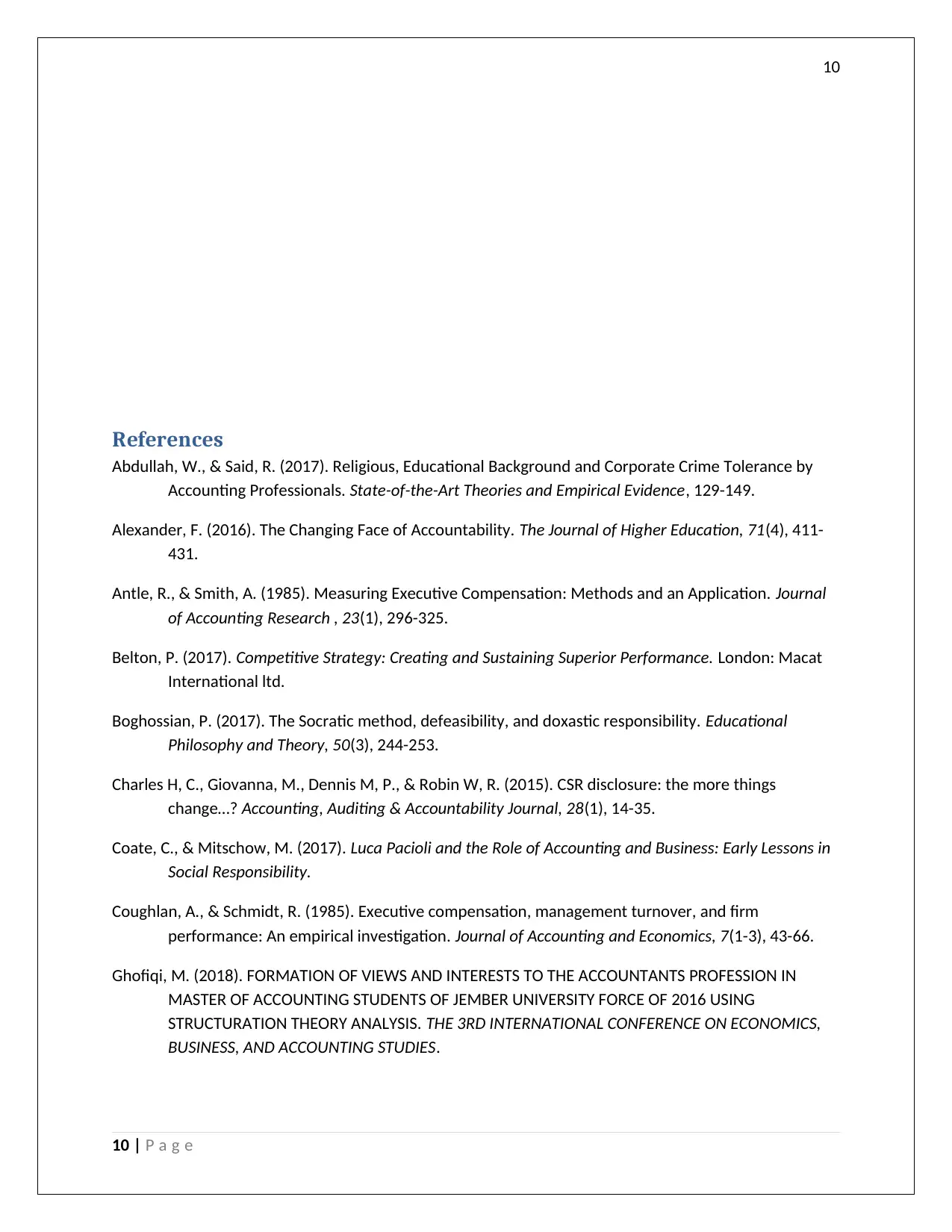
10
References
Abdullah, W., & Said, R. (2017). Religious, Educational Background and Corporate Crime Tolerance by
Accounting Professionals. State-of-the-Art Theories and Empirical Evidence, 129-149.
Alexander, F. (2016). The Changing Face of Accountability. The Journal of Higher Education, 71(4), 411-
431.
Antle, R., & Smith, A. (1985). Measuring Executive Compensation: Methods and an Application. Journal
of Accounting Research , 23(1), 296-325.
Belton, P. (2017). Competitive Strategy: Creating and Sustaining Superior Performance. London: Macat
International ltd.
Boghossian, P. (2017). The Socratic method, defeasibility, and doxastic responsibility. Educational
Philosophy and Theory, 50(3), 244-253.
Charles H, C., Giovanna, M., Dennis M, P., & Robin W, R. (2015). CSR disclosure: the more things
change…? Accounting, Auditing & Accountability Journal, 28(1), 14-35.
Coate, C., & Mitschow, M. (2017). Luca Pacioli and the Role of Accounting and Business: Early Lessons in
Social Responsibility.
Coughlan, A., & Schmidt, R. (1985). Executive compensation, management turnover, and firm
performance: An empirical investigation. Journal of Accounting and Economics, 7(1-3), 43-66.
Ghofiqi, M. (2018). FORMATION OF VIEWS AND INTERESTS TO THE ACCOUNTANTS PROFESSION IN
MASTER OF ACCOUNTING STUDENTS OF JEMBER UNIVERSITY FORCE OF 2016 USING
STRUCTURATION THEORY ANALYSIS. THE 3RD INTERNATIONAL CONFERENCE ON ECONOMICS,
BUSINESS, AND ACCOUNTING STUDIES.
10 | P a g e
References
Abdullah, W., & Said, R. (2017). Religious, Educational Background and Corporate Crime Tolerance by
Accounting Professionals. State-of-the-Art Theories and Empirical Evidence, 129-149.
Alexander, F. (2016). The Changing Face of Accountability. The Journal of Higher Education, 71(4), 411-
431.
Antle, R., & Smith, A. (1985). Measuring Executive Compensation: Methods and an Application. Journal
of Accounting Research , 23(1), 296-325.
Belton, P. (2017). Competitive Strategy: Creating and Sustaining Superior Performance. London: Macat
International ltd.
Boghossian, P. (2017). The Socratic method, defeasibility, and doxastic responsibility. Educational
Philosophy and Theory, 50(3), 244-253.
Charles H, C., Giovanna, M., Dennis M, P., & Robin W, R. (2015). CSR disclosure: the more things
change…? Accounting, Auditing & Accountability Journal, 28(1), 14-35.
Coate, C., & Mitschow, M. (2017). Luca Pacioli and the Role of Accounting and Business: Early Lessons in
Social Responsibility.
Coughlan, A., & Schmidt, R. (1985). Executive compensation, management turnover, and firm
performance: An empirical investigation. Journal of Accounting and Economics, 7(1-3), 43-66.
Ghofiqi, M. (2018). FORMATION OF VIEWS AND INTERESTS TO THE ACCOUNTANTS PROFESSION IN
MASTER OF ACCOUNTING STUDENTS OF JEMBER UNIVERSITY FORCE OF 2016 USING
STRUCTURATION THEORY ANALYSIS. THE 3RD INTERNATIONAL CONFERENCE ON ECONOMICS,
BUSINESS, AND ACCOUNTING STUDIES.
10 | P a g e
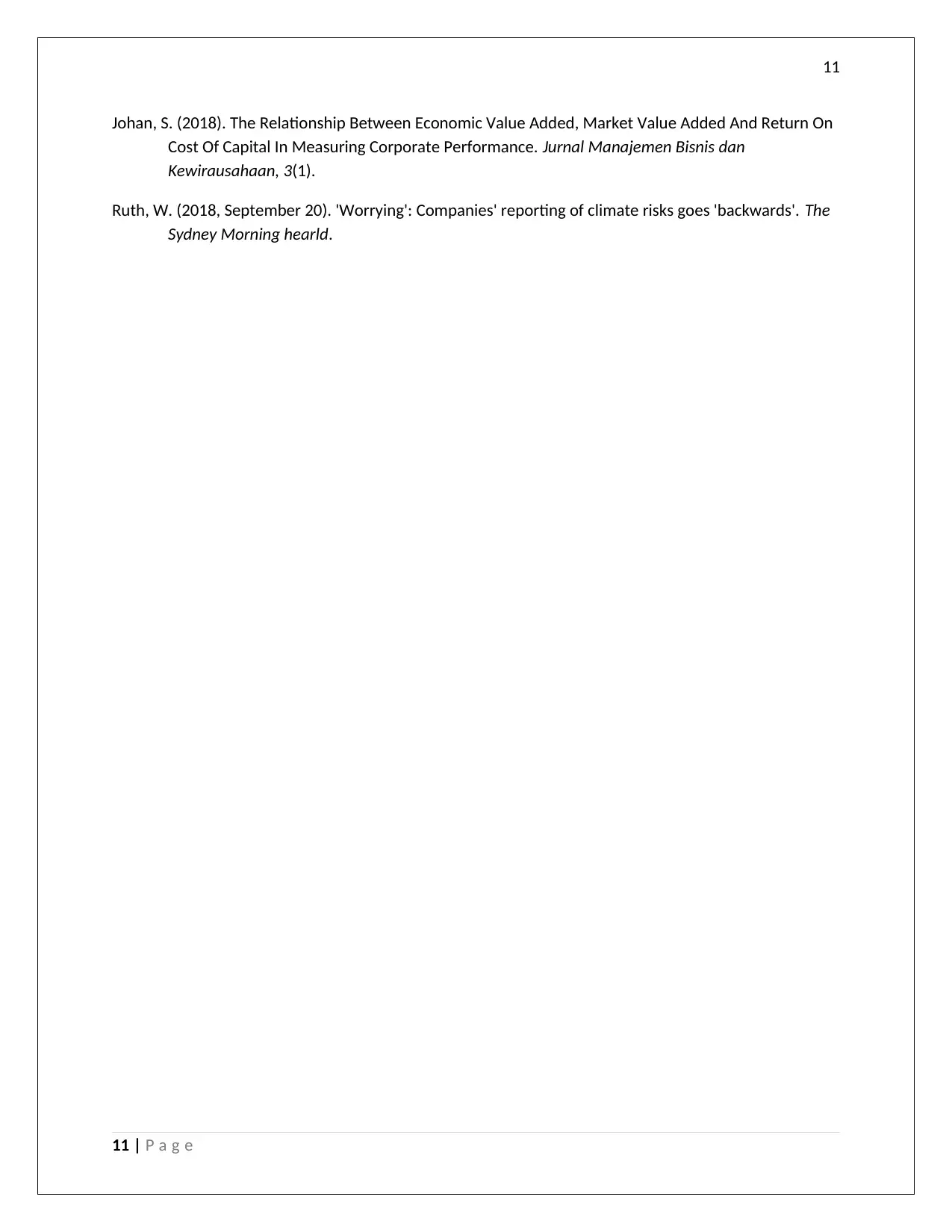
11
Johan, S. (2018). The Relationship Between Economic Value Added, Market Value Added And Return On
Cost Of Capital In Measuring Corporate Performance. Jurnal Manajemen Bisnis dan
Kewirausahaan, 3(1).
Ruth, W. (2018, September 20). 'Worrying': Companies' reporting of climate risks goes 'backwards'. The
Sydney Morning hearld.
11 | P a g e
Johan, S. (2018). The Relationship Between Economic Value Added, Market Value Added And Return On
Cost Of Capital In Measuring Corporate Performance. Jurnal Manajemen Bisnis dan
Kewirausahaan, 3(1).
Ruth, W. (2018, September 20). 'Worrying': Companies' reporting of climate risks goes 'backwards'. The
Sydney Morning hearld.
11 | P a g e
⊘ This is a preview!⊘
Do you want full access?
Subscribe today to unlock all pages.

Trusted by 1+ million students worldwide
1 out of 12
Related Documents
Your All-in-One AI-Powered Toolkit for Academic Success.
+13062052269
info@desklib.com
Available 24*7 on WhatsApp / Email
![[object Object]](/_next/static/media/star-bottom.7253800d.svg)
Unlock your academic potential
Copyright © 2020–2025 A2Z Services. All Rights Reserved. Developed and managed by ZUCOL.




